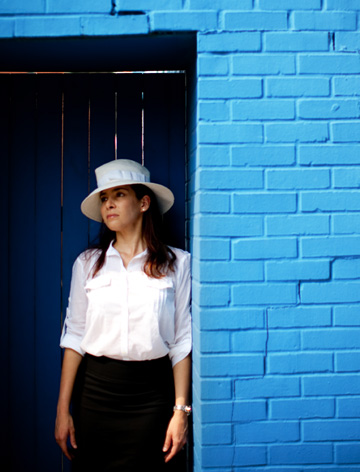This time of year, the cement sears bare feet like white-hot pokers, the pool’s a tepid bath, and the grass bristles and cracks with the sound of a rattler’s tail. Any cool breeze is a benediction. During the summer, I’ve always thought of McKinney Avenue’s trolleys trundling their way from Uptown to downtown as a sanctuary—offering air-conditioning while moving at a walking pace to see Dallas street life outside the cloister of a car.
Along the tracks, just short of the McKinney Avenue Transit Authority’s trolley barn on Oak Grove and Bowen sits the McKinney Avenue Contemporary. For 15 years its violet skin, emblazoned with Our Lady of Guadalupe on its front, has punked up the street. Home to Kitchen Dog Theater, leasing space to the Alliance Française, always housing new art exhibitions (its three gallery spaces can hold more than 20 shows a year), and open for art talks and film series, the MAC does what the Arts District is trying to do with less bombast, construction, and traffic. But perhaps because of the many roles it plays, the MAC’s identity is difficult to pin down.
Claude Albritton founded the MAC. He says it isn’t a museum or a sales-driven gallery. “It’s more like an agora than an acropolis. It doesn’t have any of the social cachet of the city’s other cultural institutions. It’s a grass-roots people space providing support for what is here,” he says. For Albritton, this sensibility responds to the work of the Dallas Nine, 1930s Texas artists who painted their local surroundings instead of traveling to Europe. They believed that the quality and caliber of their work rivaled that of their national and international counterparts. The MAC “fosters this indigenous spirit,” Albritton says, offering Texas artists a forum in which to engage each other’s work and the outside world’s.
But since the MAC offers free admission and doesn’t sell art, funding can get tight. When certain MAC events do charge admission, their prices are affordable. The MAC has no endowment nor publicity budget. Mac director Liliana Bloch says the MAC relies on leasing out space, membership, and grants and donations. Its cultural survival depends on artists, art patrons, and scholars seeing its need. All told, Albritton says, the MAC’s $400,000 annual earnings (including Kitchen Dog) make for a lean machine. “It’s difficult for any small institution to remain committed to its mission without some patronage,” he says. “The fact that the MAC’s still here after 15 years proves its own tenacity.”
For a substantial part of those 15 years, 2001 to early 2008, Elizabeth Hunt-Blanc served as the MAC’s director. A lover of Spanish art, Hunt-Blanc studied at the Prado and now works as deputy director at the Meadows Museum. During her time at the MAC, she began organizing shows with the Mexican Consulate. The MAC began to see a more international audience with a substantial Hispanic following. With Albritton’s interest in regionalism, David Dike began staging his annual auction of early Texas art at the MAC. Hunt-Blanc says that with Bloch, a Salvadoran, now heading the MAC, it’ll carry on its local and internationalist tradition. “Liliana is so excited and energetic about everything,” Hunt-Blanc says.
I can attest to Bloch’s vim. Her enthusiasm for the MAC is magnetic, and she owns the space around her. In May, she toured me around the gallery, discussing that month’s exhibits. Her eagerness and candor spilled over into talk of the MAC’s future. “The recession, a culture of instant gratification and stimulation, people’s lack of discernment between good and bad art, and general apathy and cultural disconnectedness make it hard to get people involved,” she says. It might also be that the MAC sits on McKinney’s slower belt—fewer places to pub-crawl, see and be seen.
The MAC is doing a few things to counter the culture: an education program with Travis Elementary instructs students in art and art history. A new website, blog, and Twitter and Facebook pages are engaging a savvy crowd online. “You can’t go more cosmopolitan and bohemian than by coming to the MAC,” Bloch says. “It’s got art galleries, theater, and lectures, and it’s surrounded by restaurants and bars.”
The MAC’s in a walkable area and could make for a real neighborhood joint. But its recessed entryway, guarded by a parking lot, makes it look more cavernous than inviting. A piazza adjacent to the street edge, connecting the MAC to the sidewalk, would do away with that unappealing feel. The walls partitioning the MAC from its neighbors could be removed. And the coffee bar could be a daily draw with alcohol on sale in the evenings.
This month, the MAC holds its 15th annual membership exhibit, displaying works from artists that have kept the MAC alive since 1994. The theme is “XV” or, as the website says, “Fifteen … Anything!” A quinceanera-themed reception will inaugurate the exhibition on August 1, and the show will run till the end of the month. As long as the art’s “interesting, tasteful, and substantive,” Bloch welcomes it all. After all, it’s the agora. But 15 is just a few years into teenagedom. To hit 30, the MAC needs to seduce a few more local refugees off those trolleys and into its halls.
The MAC’s 2009 Membership Exhibition, “XV,” runs from August 1 to August 29. The opening reception is August 1, 5:30 to 7:30. 214-953-1212 or www.the-mac.org.






